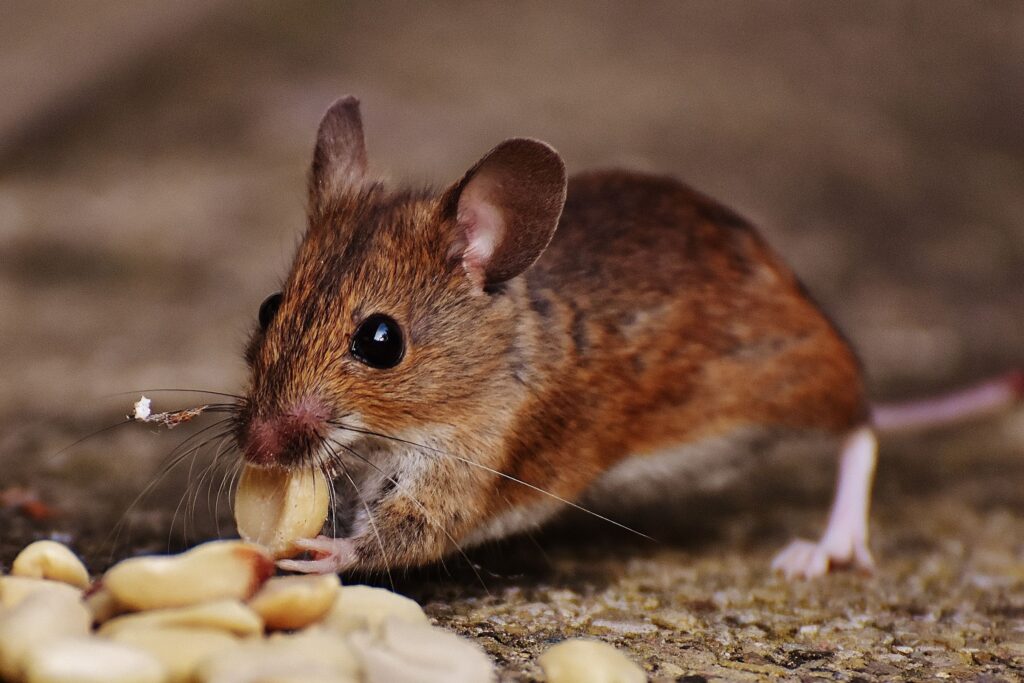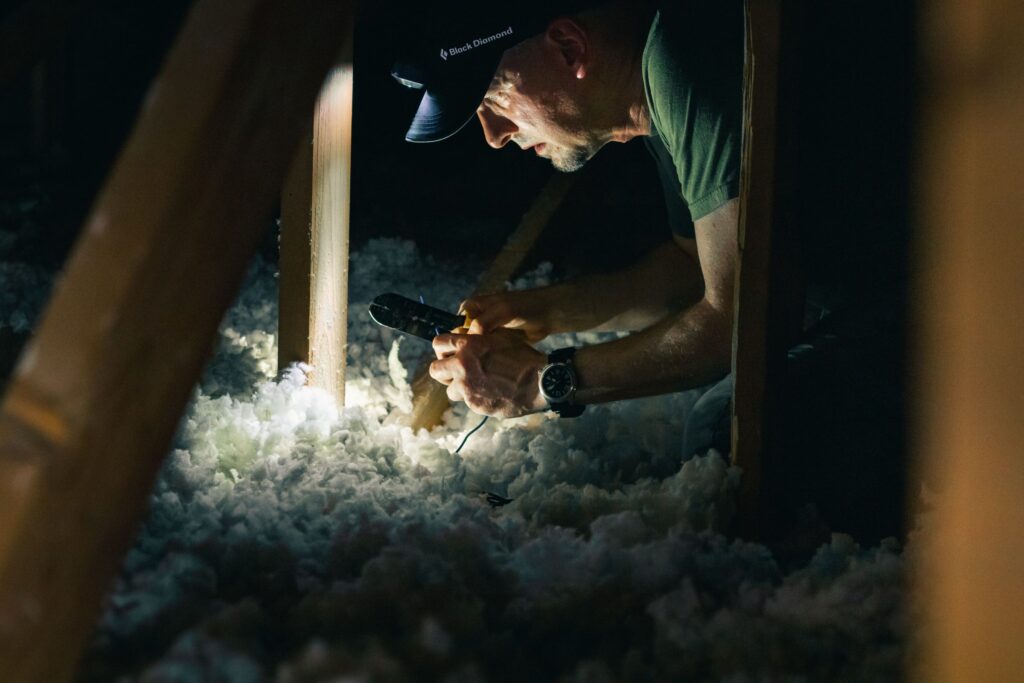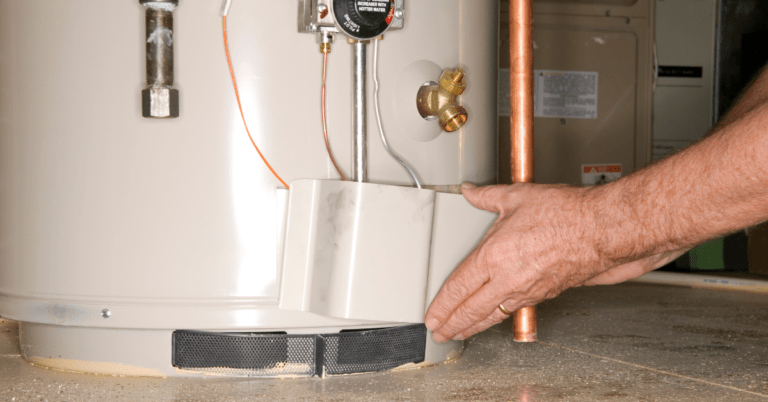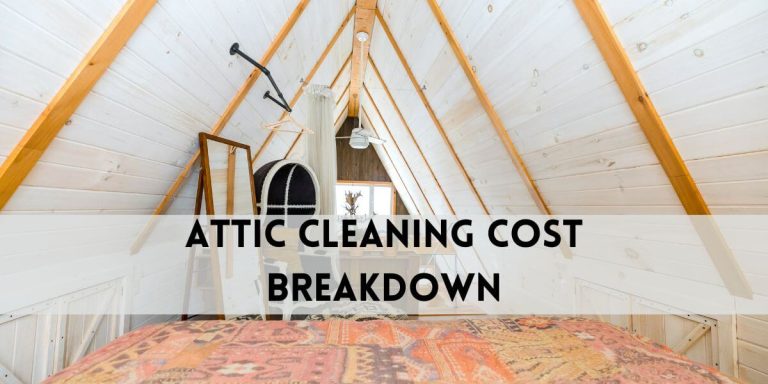What Could Be Making Noise in My Ceiling? [Possible Causes and Fixes]

It’s late, and you’re to get to bed and unwind after the long day when you suddenly hear a loud, persistent noise coming from somewhere in your attic or ceiling. Or little one is trying to sleep in their room, and rustling, scratching, or tapping noises coming from above keeps scaring them awake. These noises can make it stressful and worrying.
So, what could be making noise in the ceiling? While there are a variety of possible reasons including:
- Pest infestation such as mice or other rodents
- Wild animals in your attic such as squirrels and raccoons
- Loose HVAC ductwork
- Vibrations from plumbing
- Loose insulation
- Insect infestation
- Loose shingles
There are some easy solutions to help you get to the bottom of it and get some peace and quiet back in your home. But it all starts by figuring out the source of the sound and working from there.
A Table of the Possible Causes of Noise in Your Attic and Best Solutions
| Possible Causes of Noise | Best Solutions |
|---|---|
| Mice or other rodents | 1. Seal all entry points and gaps in the attic and walls to prevent their entry. Use steel wool or caulk to fill small holes. 2. Set up traps or use rodenticides to eliminate existing rodent infestations. 3. Keep the attic and surrounding areas clean and free from food sources to discourage rodents. |
| Squirrels or raccoons | 1. Locate and seal any entry points on the roof or exterior of the house. 2. Install mesh screens or chimney caps to prevent animals from accessing the attic. 3. Use humane traps to capture and relocate larger animals. 4. Consult with a professional wildlife removal service if necessary. |
| Insects like termites | 1. Contact a professional pest control service to assess and treat the termite infestation. 2. Repair any damaged wood and treat it with appropriate insecticides. 3. Regularly inspect and maintain the property to prevent future infestations. |
| Loose HVAC ductwork | 1. Inspect the ductwork for loose connections and reattach or secure them properly. 2. Use HVAC-specific tape or metal fasteners to seal any gaps or loose sections. 3. Consider professional HVAC maintenance to ensure the system is functioning optimally. |
| Vibrations from plumbing | 1. Inspect the plumbing system for loose pipes or fixtures and tighten them as needed. 2. Add foam insulation or rubber padding to pipes to reduce vibration and noise. 3. Consult with a plumber if necessary to address any significant plumbing issues. |
| Loose insulation | 1. Identify areas where the insulation is loose or displaced. 2. Use appropriate fasteners or adhesive to secure the insulation in place. 3. Consider replacing loose fiberglass batt insulation with a more secure type, such as blown-in insulation. |
What Could Be Making Noise in My Ceiling?
We all love peace and quiet, and in the same way, we all hate noise. Noise can be very annoying, whether it is coming from inside or outside your home. It can be stressful and frustrating, be it a dripping faucet, a creaking floorboard, or a strange scratching sound coming from the ceiling or attic.
Noise can be particularly disruptive when you are trying to sleep or relax. Whether it’s during the night or early in the morning, the last thing you want is to be woken up by strange and disturbing sounds coming from your home. It’s a problem that many of us face.
Fortunately, there are a few things you can do to help mitigate the impact of these noises and get peace of mind. However, you need to know the cause of these attic and ceiling noises.
So, what are the possible causes of noises in the attic and ceiling? Some common causes of noise in the attic or ceiling include:
Mice or other rodents

Pests like mice and rats can easily find their way into attics through minute gaps and openings around plumbing and electrical wires, ventilation systems, eaves, and soffits. They create disturbances by foraging for nesting and construction materials by chewing on soft insulation and aluminum sheathing.
They also feed on electrical wiring insulation and corroded copper pipes leading to electrical and water issues. The rodents make scratching sounds as they travel across floor joists and trusses to nesting sites. Their urine and feces can lead to serious health risks if left unchecked.
Solutions
- Locate all entry points like holes and cracks and seal them with steel wool, metal mesh, or caulk to keep mice out.
- Set multiple snap traps with baits like peanut butter to remove any mice currently in the attic.
- Closely monitor the traps and continue trapping until no new mice are caught.
- Limit access to food and water sources that attract mice by removing debris and contaminants from the attic.
- Periodically inspect the attic, especially during warmer seasons, to identify and fix small issues before they become major infestations.
- Replace damaged materials like contaminated insulation and nesting materials to fully resolve the issue.
- Consult with a professional pest control company if the mice are causing significant damage or the infestation is too large to tackle on your own. Professional pest removal will eliminate all mice and nests to prevent future problems.
Squirrels and Raccoons
Larger animals like squirrels and raccoons gain entry to attics through soffit vents, unscreened chimneys, and openings around plumbing stacks and exhaust fans.
Once inside, they rummage for food and nesting materials, causing disturbances by climbing across rafters and trusses. They also gnaw on exposed wiring, pipes, and structural woodwork creating chewing and biting sounds.
The animals often defecate and urinate on insulation and framing members which can lead to odor issues and potential structural damage over time.
Solutions
- Find all points of entry and seal them with galvanized metal or wire mesh. Install chimney caps and covers on vents to also keep these animals out.
- Use live traps to safely remove any existing animals in the attic.
- Limit food and water sources around the exterior of the home to discourage animals from returning.
- Use smells that will deter raccoons and other wild animals from getting into your home.
- If the issue persists, consult with a professional wildlife removal service to remove animals in a safe and humane manner.
- Perform periodic attic decluttering inspections to identify and address small issues before they become major problems, preventing future animal infestations.
- Replace damaged or contaminated materials like insulation, drywall, and framing members to fully solve the issue and restore a pest-free environment.
Insect Infestation
A variety of insects can infest ceilings including termites, carpenter ants, beetles, and cockroaches. They enter through cracks, gaps, and small holes to access wood and cellulose materials for food and nesting sites.
- Termites: They feed mainly on wooden joists, studs, and insulation. As they tunnel and forage, they produce crackling and popping sounds. Given enough time, termite infestations can cause serious damage requiring deep inspections of the structure.
- Carpenter Ants: They nest in damp wood like window sills, frames, and joists. Their tunneling produces dust and frass (ant droppings). Left unchecked, carpenter ants can significantly weaken wooden structures.
- Beetles: Powderpost and wood-boring beetles primarily target wooden components, leaving tiny holes and dust piles made of frass and wood particles. Extensive beetle damage may compromise structural integrity.
- Cockroaches: They are not typically wood-borers but seek sheltered areas to live and reproduce. They produce noise from movement and shed their exoskeletons that can accumulate in ceiling spaces.
Solutions
- Hire professionals to thoroughly inspect the ceiling, and identify the specific insect(s) and extent of damage.
- Repair or replace damaged wood for severe infestations.
- Treat all infested and affected areas with appropriate insecticides. Sprays, dusts, and baits can be applied to eliminate insects and prevent further damage.
- Seal cracks and crevices to exclude future insect intrusion using caulk, foam, or sealants. Insect-repellent gels can be applied to potential entry points.
- Monitor infested areas regularly after treatment for signs of additional activity. Residual insecticides may need to be reapplied.
Loose HVAC ductwork
When HVAC ductwork becomes loose or disconnected in your attic, it can produce a range of noises that resonate through the ceiling. The most common culprits are:
- Vibrating ducts: When duct connections become loose over time or are improperly installed, the ductwork can vibrate against framing members or insulation as air flows through the system. This causes a rattling, banging or oscillating noise.
- Rubbing ducts: Duct sections that become disconnected can rub against each other or joists when the HVAC unit cycles on, producing a scratching or scraping noise.
- Knocking ducts: Loose ducts that knock together intermittently can create an intermittent knocking or thumping sound that is loudest when the system is running.
The key to resolving HVAC duct noise issues is identifying and securing or reconnecting any vibrating, rubbing, or knocking ductwork. This may involve:
- Inspect the entire duct system for loose connections, brackets, or clamps that have failed. Pay attention to spots where ducts change direction or join together.
- Reconnect and secure ductwork joints with proper HVAC tape, cable ties, clamps, or strap hangers designed for duct systems.
- Add insulation or rubber padding around ducts that are in direct contact with joists or other ductwork to reduce vibration and noise.
- Hire a professional HVAC contractor if the issue is severe or you lack the equipment to access and properly secure ductwork in your attic.
- Schedule annual duct inspections and maintenance to identify minor issues before they cause noise problems or decrease HVAC efficiency.
- Replace deteriorating ductwork materials that are prone to leaks and vibrations over time.
Vibrations from Plumbing
Loose or vibrating plumbing pipes and fixtures located above a ceiling can often cause noise issues. As water flows through pipes, any small movements or vibrations are transmitted to the surrounding structure and ceiling.
This usually results in intermittent knocking, clicking, or thumping sounds which can be annoying and hard to pinpoint the source. Over time, constant vibrations from plumbing can also cause fatigue on connections and joints and loosen hangers and fixtures.
Solutions
- Inspect all plumbing pipes and fixtures above the ceiling for any signs of loose connections, worn fittings or hangers, and leaking joints.
- Tighten any loose joints, nuts, or hangers to secure pipes and fixtures and stop vibrations at the source.
- Add foam tape, rubber grommets, or pipe insulators around pipes to absorb minor vibrations before they reach the ceiling.
- Install additional hangers, straps, or braces as needed to better secure pipes to the framing and reduce movements.
- Consult with a professional plumber if there are any major issues like corroded pipes, severely worn fittings, or deteriorating hanger systems. They can replace or retrofit parts to resolve the vibration issues permanently.
- As part of regular plumbing maintenance, inspect all exposed piping for signs of wear, corrosion, or deterioration. Making minor repairs before they become major problems can prevent noise issues from developing.
Loose Insulation
Over time, insulation can start to shift, settle or pull away from its original position. This is common with fiberglass batt insulation which is not secured firmly in place. Even spray foam insulation can loosen from framing members.
When insulation moves around, it can cause rustling, crackling, and scratching noises as it brushes against other materials like ductwork, wiring, and ceiling fixtures. Gaps that form as insulation shifts can also reduce their effectiveness.
Solutions
- Inspect the insulation from the attic side to locate areas where it has loosened, separated from framing, or developed gaps.
- Use wire ties, staples, nails, or insulation retention pins to firmly secure batt insulation back into place.
- Apply spray foam insulation into gaps to fill spaces and secure loose pieces.
- For fiberglass batts that are severely damaged or cannot be properly resecured, consider replacing them with a more secure type of insulation like blown cellulose or spray foam.
- Adhere unfaced batt insulation to framing members or joists using an adhesive spray specifically made for insulation.
- During regular inspections of the attic, look for signs of loose insulation and make minor repairs before it becomes a more significant problem.
- Properly securing and filling gaps in insulation can eliminate noises and restore its installed R-value, providing energy savings and a quieter environment.
Leaks and Condensation in Your Home
Another culprit when it comes to noises in your attic and ceiling is a leaky roof or condensation. This can cause drips, which may be the source of that dripping sound you’ve been hearing. If left untreated, this can be a serious issue, so it’s important to address any leaks or condensation as soon as you notice it.
Other Possible Causes
Why does it sound like there is something in my walls? There are, of course, many other possible causes of noises in your attic and ceiling. Some common include:
- Birds in the Morning and Afternoon: Birds can also be a nuisance in the attic, particularly if they are nesting. They may make chirping or tapping noises as they move about and build their nest. It might be challenging to identify the specific type of bird based on sound alone, but it is worth investigating.
- Bats at Night: If bats have found a way to your attic, they may be crashing around and squeaking as they fly around. Typically, they will make these noises as they move around and hunt for food at night.
- Opossums or possums: These nocturnal animals are another common culprit behind noises in the attic. They like eating a variety of foods, including insects and rodents. Like raccoons, these animals are also sneaky and quiet during the day but may make noise at night.
How To Identify The Cause of Noise in the Attic, Ceiling, and Walls
If you are bothered by noises in your attic, ceiling, or walls, the best thing you can do is identify the cause. This can be done by investigating all the possible causes, such as those listed above. Other tips for identifying the source of attic and ceiling noises include:
- Conduct a thorough visual inspection of your attic and ceiling to look for signs of pests, leaks, or structural issues.
- Listen closely to the noises you hear, and determine if they change based on specific factors, such as time of day or weather conditions.
- Consult with a professional to get their input on the potential causes of noises in your attic and ceiling.
- Do a home inspection to look for any potential issues related to ventilation, foundation settling, or other factors that could be contributing to the noises.
- If you suspect electrical issues, call an electrician to have your systems assessed and any necessary repairs made.
How do I stop my ceiling from making noise?
Identifying the cause of the attic and ceiling noises is the first step of the process, but once you have done this, there are various strategies you can use to address the issue. Some possible steps for dealing with noise in the attic, ceiling, and walls include:
Properly Insulating Your Attic and Ceiling

If you found out that the cause of the noise is animals, birds, or insects in your attic and ceiling, one effective solution is to properly seal and insulate these areas. This will help block out unwanted sounds, and may also help prevent other issues related to poor insulation. Add insulation, weatherstripping, and other materials that will help block off access points and prevent sound waves from traveling.
Conduct Repairs or Maintenance as Needed
If you suspect leaks in your roof or other structural issues causing the noises in your attic, ceiling, and walls, be sure to address these as soon as possible. This may involve repairs or simple maintenance tasks such as tightening loose screws or replacing damaged insulation.
Consider Using Soundproofing Materials
In some cases, noise in the attic, ceiling, and walls may be caused by sound waves reverberating throughout your home. In this case, soundproofing materials such as acoustic foam can help absorb these sound waves and reduce the overall noise levels.
Pest Control
You can also prevent potential pests from making your attic and ceiling their home by addressing any signs of pests or other unwanted visitors promptly. Some DIY pest control options include sealing up cracks in your ceiling and walls, installing screens over vents and other openings, and using natural deterrents such as essential oils to keep pests at bay.
You can also hire pest control services near you to help you get rid of pests and prevent them from returning in the future. That will take away the hassle of crawling up there and fixing the noise yourself.
Seek Professional Help If Necessary
If you cannot identify or address the cause of the noise in your attic and ceiling, it may be wise to seek professional help. A home inspector or expert can assess your home, help you find the source of the noises, and recommend any necessary repairs or other solutions.
FAQs:
Is it normal to hear noises in my attic?
Yes, it is quite normal for your attic and ceiling to make noises from time to time. Some of the most common causes include wind-related issues, mechanical problems with appliances and electrical features, pests such as rodents or bats, or structural problems such as leaks or settling.
Do soundproofing materials really work?
Yes, soundproofing materials can be a highly effective way to reduce noise in your attic and ceiling. This may involve using acoustic foam or other materials that absorb sound waves and sealing up any gaps or cracks to prevent sound from entering or leaving your attic.
What causes buzzing sound in the attic?
The most common causes of buzzing sounds in your attic are the insects such as bees and wasps. They create the sound as they fly around or build a nest in your attic.
How do I scare animals out of my attic?
You can try playing music, using bright light, placing rags soaked in vinegar, or spraying them with water.
Conclusion
Listening to the noise in your attic and ceiling can be frustrating and disruptive. Whether the cause of the noise is structural issues, pests, or other factors, there are several strategies you can use to address the issue. Some steps you may want to consider include properly insulating your attic and ceiling, conducting repairs or maintenance as needed, using soundproofing materials to absorb sound waves, and using pest control methods to scare away unwanted animals. If necessary, you can also seek professional help from a home inspector or other expert to guide you in finding the source of the noises and recommend any necessary repairs or solutions.







![How Much Does Crawl Space Vapor Barrier Cost? [Answered]](https://www.homeimprovementdock.com/wp-content/uploads/2023/08/How-Much-Does-It-Cost-To-Install-Vapor-Barrier-In-Crawl-Space-Answered-2-768x403.jpg)
In this regard, I want to share additional information about the company, which can be found at https://www.lakewoodexterminating.com/. This company is dedicated to pest and insect management and they can also help with environmental noise issues. If the noise is caused by insects or rodents, Lakewood Exterminating can provide professional pest control services. Their experienced professionals have used techniques to ensure the comfort and safety of your home.
Okay. Don’t forget to share the post with friends.